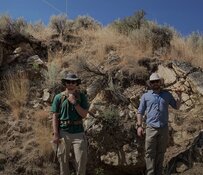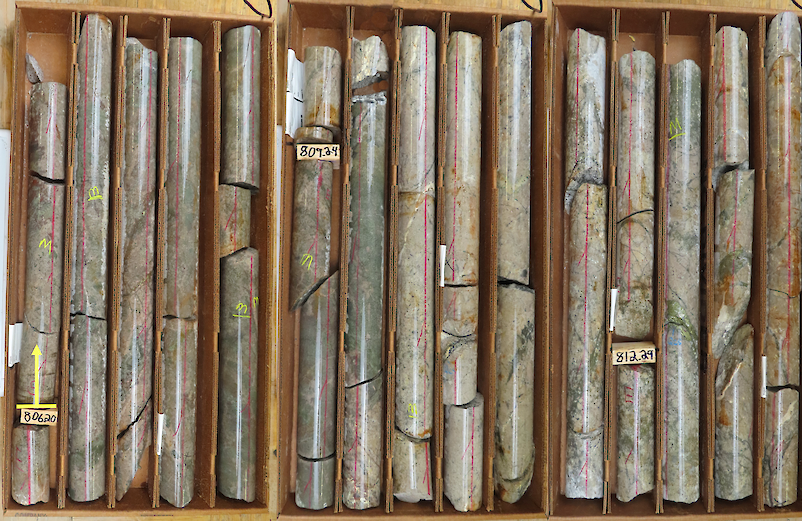TICKERS: AVL; AVARF, , , , REEMF,
Mickey Fulp: Double or Nothing
Interview
Source: Karen Roche of The Gold Report (3/21/11)
 In this exclusive interview with The Gold Report, Mercenary Geologist Mickey Fulp touches on wide-ranging topics from the coming correction in gold to the criteria he uses to evaluate the "best of the best" stocks that he presents in his periodic Musings. Among them—if he can't see a double within 12 months, Mickey will walk on by.
In this exclusive interview with The Gold Report, Mercenary Geologist Mickey Fulp touches on wide-ranging topics from the coming correction in gold to the criteria he uses to evaluate the "best of the best" stocks that he presents in his periodic Musings. Among them—if he can't see a double within 12 months, Mickey will walk on by.
The Gold Report: Returns from some of the companies you've written about since you launched Mercenary Musings in the summer of 2008 have been nothing short of astonishing. While some of the price appreciation came with the markets recovering from their 2008 lows, we see doubles, triples, quadruples, five and sixbaggers—even one twentybagger. Now that the markets have rebounded, how much do you expect juniors to increase over the next 12 months?
Mickey Fulp: That is a speculation fraught with difficulty. I expect commodities to remain at high prices but also expect food inflation and resulting unrest and turmoil in emerging market countries to continue. This could affect all world stock markets negatively. All the North American markets are long overdue for a correction.
TGR: If you're anticipating a pullback in the general markets, do you think your picks in 2011 can achieve doubles in 12 months or less?
MF: I pick only the stocks that I think have strong chances to double in 12 months or less. That is the criteria under which I operate.
TGR: Gold experienced a 23% gain in the last nine months. To what extent do you foresee that rate of appreciation continuing?
MF: Gold is overdue for a correction and, in fact, was in the midst of one with a 7% drop before Middle East turmoil in late January caused safe-haven and speculative buying. In my opinion, recent geopolitical issues have distorted the precious metals markets, caused safe-haven buying and prevented a full-blown correction from occurring.
TGR: How much of a correction are you anticipating in gold? Then, once it does correct, do you expect it to return and exceed its previous high this year?
MF: A market correction is defined as a 10%–30% drop. Corrections are always healthy because markets, commodities or stocks appreciate too fast and become frothy, risky and overbought. A 10-year chart of gold shows a near-constant increase in price year-over-year, so I expect that trend to continue. The gold price is driven largely by worldwide currency devaluation and gold always maintains its purchasing power over the long term.
TGR: To what extent will gold prices need to continue increasing for gold juniors to appreciate?
MF: The gold price recently forged ahead of the stock market with a selloff in junior gold explorers as profits were taken after a robust run-up over several months. Keep in mind, juniors generally correct more than the gold price because they are purely speculative and volatile plays.
TGR: In a December Mercenary Musing, you wrote that nearly all juniors will have a low to high double in any given 52-week period. Could you elaborate on that?
MF: I'll challenge anyone to find an active junior with a running 52-week high and low that's not at least a double. That's because juniors operate in phases of acquisition, financing, exploration, receipt of results and reporting. The stock price tends to go from low to high within each phase. Low and high price cycles correspond to low and high volumes. By employing a contrarian philosophy, i.e., buying at low volumes and low prices and selling at high volumes and high prices, we can achieve consistent doubles.
TGR: Could you update us on some of the undervalued juniors you discussed during your interview with The Gold Report last fall?
MF: With Otis Gold Corp. (TSX:OOO; OTCBB:OGLDF), Mine Ridge drill results are complete and the company hit on 31 of 35 holes in 2011. I think resources will increase significantly with a new qualified estimate, but delivery of that has been delayed. Also, the company recently announced new drill-hole success at the Dog Bone Ridge prospect with 2 of 5 blind holes hitting significant gold mineralization, including a near-surface intercept of 9 meters at 1.3 g/t Au and another with 138m of anomalous gold.
I covered OOO a year ago at $0.52. It reached a high of $0.84 in late December but has drifted down since then. I see two reasons that the market capitalization of Otis Gold has been lower recently: 1) Lack of timely news releases on drill results and delay in a new resource estimate due to tardiness of company geologists in logging and processing core, drawing cross sections, reporting drill results and delivering data to resource engineers; and 2) Lack of a focused and concerted marketing and promotion effort by management. Simply put, the Otis Gold team has not performed to my expectations. I hope that improves.
TGR: That said, do you still like the company?
MF: Yes. Because I like the company's share structure, flagship project and people, I continue to hold my shares of Otis Gold. The target price for both my subscribers and me is more than $1.04 by mid-May, basically 15 months to double. The catalyst will be a new resource estimate that I expect will significantly increase the number of ounces of gold in the ground. But even if the price doubles, Otis will still be undervalued with respect to its peers.
TGR: Rare earths continue to be a hot topic, though now people more often call them either "strategic" or "technology" metals. You've described this as a "conflicted categorization."
MF: All these newly coined terms for what used to be called "minor" or "specialty" metals are conflicted categorizations and confuse the investor. I object to the terms rare, strategic, technology and/or critical metals. The specialty metals have the following characteristics: They have minor but special uses, do not trade in appreciable tonnages or dollar amounts, do not trade on open world markets and often are controlled by a single country, company or cartel. Security of supply is a concern to those who depend on geopolitically unstable, corrupt or unfriendly sources. Rare earth elements are a part of the much larger group of specialty metals.
TGR: As you've pointed out, the REE sector graduated from "flavor of the year" in 2009 to forge ahead in 2010 with valuations increasing exponentially. Although much has been written about China's export quotas, particularly in terms of the REEs, another issue came up during a strategic metals conference in January—the cost to extract and refine these metals.
MF: Metallurgy and processing is a potential fatal flaw for all REE projects. There should be priority given to construction of a complex to separate and process heavy rare earth elements (HREEs) outside of China, and preferably in North America. It is the logical solution for a HREE project on this continent to ultimately succeed.
TGR: How has this potential, fatal flaw impacted investment in the industry?
MF: So far, there has been little impact on speculation in the companies with exploration projects of merit. I expect increased awareness as we get further into 2011 and hope to see a new effort made to address this important issue. There are, however, alternatives for developers and miners, such as offtake contracts or strategic alliances with users who have access to processing facilities in China.
I just think it makes sense if we can go mine-to-market for all the rare earths in the United States. Our government seems to think so, too, though they say it will take 15 years to happen. Being an exploration geologist and, as such, realistically skeptical but generally optimistic, I think that can be fast-tracked.
TGR: You've indicated that only a few companies in the REE space have the share structure, people and flagship projects worthy of speculation for ultimate success through the 2011–2016 period. You consider three of the stocks you hold long-term plays. Can you provide us with a quick update on these companies?
MF: Sure. The three are Quest Rare Minerals Ltd. (TSX.V:QRM), Rare Element Resources Ltd. (TSX.V:RES; NYSE.A:REE) and Tasman Metals Ltd. (TSX.V:TSM; Fkft:T61; OTCPK:TASXF).
Quest released final drill results from 2011 drilling at Strange Lake in mid-January. Geologists have outlined a thick, high-grade zone called the Pegmatite Spine both within and extending the currently known resource to the north. A new resource estimate is expected within the next month and the company will proceed to a prefeasibility study. I expect an AMEX listing in Q2; if performance mimics recent AMEX listings by RES and Avalon Rare Metals Inc. (TSX:AVL; NYSE.A:AVL; OTCQX:AVARF), we will see increased interest from American investors, better liquidity and a higher share price. I am a committed long-term investor in this company.
Rare Element Resources announced final drill results from both its Sundance Gold and the Bull Hill REE projects. Gold results were positive on all three known deposits, and the company just announced 947,000 ounces (Koz.) of gold in an inferred resource estimate. I expect to see RES announce the spinout of a new gold company within the next year. At Bull Hill, the mineralized areas continue to expand significantly. The company anticipates delivery of a new resource estimate in Q2 and a prefeasibility study to commence shortly thereafter.
Tasman is currently drilling at its flagship Norra Karr property in Sweden. Its 2011 program is designed to drill the deposit on 100-meter centers, generate material for further metallurgical testing, deliver a new resource estimate and complete a scoping study. The company also will commence work on its other significant rare earth projects in Scandinavia. I will visit this project in late spring.
TGR: You describe next-generation companies as penny stocks that might achieve something big between 2016 and 2021, and you have identified a company in the REE space that you say could be a leader in this next generation of successful REE companies. It seems we may have quite a wait in store if something big won't happen until 2016 or so; could you talk about what might be attractive about this particular stock in the meantime?
MF: The company is Medallion Resources Ltd. (TSX.V:MDL; OTCQX:MLLOF), and its experienced management has a strategic plan to shortcut peers with forward-thinking acquisitions. The company's current projects are not why I own it. By the end of 2011, I expect news about a monazite heavy mineral sands project that can be fast-tracked to production and an HREE ionic clay project outside of China.
TGR: You just returned from PDAC. What's the "buzz" in the precious metals from that conference?
MF: Although precious metals markets are completely overbought, the gold and silver bugs are full of grandiose ideas about exorbitant prices in the future. To me, it's a broken record that's reminiscent of the Beatles' "Number nine, number nine, number nine" from the White Album. The junior resource stocks will continue to sell off as industry and market pros take profits and front-run ahead of the Sell-in-May–and-Go Away philosophy. It is always a good idea to take profits when markets are going higher, using open-order programmed selling and setting programmed profit stops to sell on the corrections and downticks.
TGR: Did you uncover any interesting new companies that you will be looking into?
MF: Yes, in fact, I recently invested in three newly formed companies in the uranium, precious metals and oil and gas sectors. They are high-risk speculations that may be presented to subscribers in the future as the companies and their markets develop and the risks are better quantified.
As a professional junior resource investor, my risk appetite is much higher than I would encourage for anyone else. I currently cover 11 stocks but speculate in well over 30. I present only "the best of the best" to subscribers (i.e., those that I think have the best chances to double within 12 months). I encourage every investor to visit my website and read my musings for doing thorough due diligence on junior resource stocks.
Michael S. "Mickey" Fulp is author of The Mercenary Geologist. He is a certified professional geologist with a B.Sc. in earth sciences with honors from the University of Tulsa and M.Sc. in geology from the University of New Mexico. Mickey has more than 30 years experience as an exploration geologist searching for economic deposits of base and precious metals, industrial minerals, coal, uranium, oil and gas and water in North and South America, Europe and Asia. Mickey has worked for junior explorers, major mining companies, private companies and investors as a consulting economic geologist for the past 22 years, specializing in geological mapping, property evaluation and business development.
Want to read more exclusive Gold Report interviews like this? Sign up for our free e-newsletter, and you'll learn when new articles have been published. To see a list of recent interviews with industry analysts and commentators, visit our Expert Insights page.
DISCLOSURE:
1) Karen Roche of The Gold Report conducted this interview. She personally and/or her family own shares of the following companies mentioned in this interview: None.
2) The following companies mentioned in the interview are sponsors of The Gold Report: Otis Gold, Quest Rare Minerals, Rare Element Resources, Avalon Rare Metals and Medallion Resources.
3) Mickey Fulp: I personally and/or my family own shares of the following companies mentioned in this interview: Otis Gold Corp., Quest Rare Minerals, Rare Element Resources, Tasman Metals, Avalon Rare Metals and Medallion Resources. I personally and/or my family am paid by the following companies mentioned in this interview: All companies mentioned are sponsors of my website.
Mickey Fulp: That is a speculation fraught with difficulty. I expect commodities to remain at high prices but also expect food inflation and resulting unrest and turmoil in emerging market countries to continue. This could affect all world stock markets negatively. All the North American markets are long overdue for a correction.
TGR: If you're anticipating a pullback in the general markets, do you think your picks in 2011 can achieve doubles in 12 months or less?
MF: I pick only the stocks that I think have strong chances to double in 12 months or less. That is the criteria under which I operate.
TGR: Gold experienced a 23% gain in the last nine months. To what extent do you foresee that rate of appreciation continuing?
MF: Gold is overdue for a correction and, in fact, was in the midst of one with a 7% drop before Middle East turmoil in late January caused safe-haven and speculative buying. In my opinion, recent geopolitical issues have distorted the precious metals markets, caused safe-haven buying and prevented a full-blown correction from occurring.
TGR: How much of a correction are you anticipating in gold? Then, once it does correct, do you expect it to return and exceed its previous high this year?
MF: A market correction is defined as a 10%–30% drop. Corrections are always healthy because markets, commodities or stocks appreciate too fast and become frothy, risky and overbought. A 10-year chart of gold shows a near-constant increase in price year-over-year, so I expect that trend to continue. The gold price is driven largely by worldwide currency devaluation and gold always maintains its purchasing power over the long term.
TGR: To what extent will gold prices need to continue increasing for gold juniors to appreciate?
MF: The gold price recently forged ahead of the stock market with a selloff in junior gold explorers as profits were taken after a robust run-up over several months. Keep in mind, juniors generally correct more than the gold price because they are purely speculative and volatile plays.
TGR: In a December Mercenary Musing, you wrote that nearly all juniors will have a low to high double in any given 52-week period. Could you elaborate on that?
MF: I'll challenge anyone to find an active junior with a running 52-week high and low that's not at least a double. That's because juniors operate in phases of acquisition, financing, exploration, receipt of results and reporting. The stock price tends to go from low to high within each phase. Low and high price cycles correspond to low and high volumes. By employing a contrarian philosophy, i.e., buying at low volumes and low prices and selling at high volumes and high prices, we can achieve consistent doubles.
TGR: Could you update us on some of the undervalued juniors you discussed during your interview with The Gold Report last fall?
MF: With Otis Gold Corp. (TSX:OOO; OTCBB:OGLDF), Mine Ridge drill results are complete and the company hit on 31 of 35 holes in 2011. I think resources will increase significantly with a new qualified estimate, but delivery of that has been delayed. Also, the company recently announced new drill-hole success at the Dog Bone Ridge prospect with 2 of 5 blind holes hitting significant gold mineralization, including a near-surface intercept of 9 meters at 1.3 g/t Au and another with 138m of anomalous gold.
I covered OOO a year ago at $0.52. It reached a high of $0.84 in late December but has drifted down since then. I see two reasons that the market capitalization of Otis Gold has been lower recently: 1) Lack of timely news releases on drill results and delay in a new resource estimate due to tardiness of company geologists in logging and processing core, drawing cross sections, reporting drill results and delivering data to resource engineers; and 2) Lack of a focused and concerted marketing and promotion effort by management. Simply put, the Otis Gold team has not performed to my expectations. I hope that improves.
TGR: That said, do you still like the company?
MF: Yes. Because I like the company's share structure, flagship project and people, I continue to hold my shares of Otis Gold. The target price for both my subscribers and me is more than $1.04 by mid-May, basically 15 months to double. The catalyst will be a new resource estimate that I expect will significantly increase the number of ounces of gold in the ground. But even if the price doubles, Otis will still be undervalued with respect to its peers.
TGR: Rare earths continue to be a hot topic, though now people more often call them either "strategic" or "technology" metals. You've described this as a "conflicted categorization."
MF: All these newly coined terms for what used to be called "minor" or "specialty" metals are conflicted categorizations and confuse the investor. I object to the terms rare, strategic, technology and/or critical metals. The specialty metals have the following characteristics: They have minor but special uses, do not trade in appreciable tonnages or dollar amounts, do not trade on open world markets and often are controlled by a single country, company or cartel. Security of supply is a concern to those who depend on geopolitically unstable, corrupt or unfriendly sources. Rare earth elements are a part of the much larger group of specialty metals.
TGR: As you've pointed out, the REE sector graduated from "flavor of the year" in 2009 to forge ahead in 2010 with valuations increasing exponentially. Although much has been written about China's export quotas, particularly in terms of the REEs, another issue came up during a strategic metals conference in January—the cost to extract and refine these metals.
MF: Metallurgy and processing is a potential fatal flaw for all REE projects. There should be priority given to construction of a complex to separate and process heavy rare earth elements (HREEs) outside of China, and preferably in North America. It is the logical solution for a HREE project on this continent to ultimately succeed.
TGR: How has this potential, fatal flaw impacted investment in the industry?
MF: So far, there has been little impact on speculation in the companies with exploration projects of merit. I expect increased awareness as we get further into 2011 and hope to see a new effort made to address this important issue. There are, however, alternatives for developers and miners, such as offtake contracts or strategic alliances with users who have access to processing facilities in China.
I just think it makes sense if we can go mine-to-market for all the rare earths in the United States. Our government seems to think so, too, though they say it will take 15 years to happen. Being an exploration geologist and, as such, realistically skeptical but generally optimistic, I think that can be fast-tracked.
TGR: You've indicated that only a few companies in the REE space have the share structure, people and flagship projects worthy of speculation for ultimate success through the 2011–2016 period. You consider three of the stocks you hold long-term plays. Can you provide us with a quick update on these companies?
MF: Sure. The three are Quest Rare Minerals Ltd. (TSX.V:QRM), Rare Element Resources Ltd. (TSX.V:RES; NYSE.A:REE) and Tasman Metals Ltd. (TSX.V:TSM; Fkft:T61; OTCPK:TASXF).
Quest released final drill results from 2011 drilling at Strange Lake in mid-January. Geologists have outlined a thick, high-grade zone called the Pegmatite Spine both within and extending the currently known resource to the north. A new resource estimate is expected within the next month and the company will proceed to a prefeasibility study. I expect an AMEX listing in Q2; if performance mimics recent AMEX listings by RES and Avalon Rare Metals Inc. (TSX:AVL; NYSE.A:AVL; OTCQX:AVARF), we will see increased interest from American investors, better liquidity and a higher share price. I am a committed long-term investor in this company.
Rare Element Resources announced final drill results from both its Sundance Gold and the Bull Hill REE projects. Gold results were positive on all three known deposits, and the company just announced 947,000 ounces (Koz.) of gold in an inferred resource estimate. I expect to see RES announce the spinout of a new gold company within the next year. At Bull Hill, the mineralized areas continue to expand significantly. The company anticipates delivery of a new resource estimate in Q2 and a prefeasibility study to commence shortly thereafter.
Tasman is currently drilling at its flagship Norra Karr property in Sweden. Its 2011 program is designed to drill the deposit on 100-meter centers, generate material for further metallurgical testing, deliver a new resource estimate and complete a scoping study. The company also will commence work on its other significant rare earth projects in Scandinavia. I will visit this project in late spring.
TGR: You describe next-generation companies as penny stocks that might achieve something big between 2016 and 2021, and you have identified a company in the REE space that you say could be a leader in this next generation of successful REE companies. It seems we may have quite a wait in store if something big won't happen until 2016 or so; could you talk about what might be attractive about this particular stock in the meantime?
MF: The company is Medallion Resources Ltd. (TSX.V:MDL; OTCQX:MLLOF), and its experienced management has a strategic plan to shortcut peers with forward-thinking acquisitions. The company's current projects are not why I own it. By the end of 2011, I expect news about a monazite heavy mineral sands project that can be fast-tracked to production and an HREE ionic clay project outside of China.
TGR: You just returned from PDAC. What's the "buzz" in the precious metals from that conference?
MF: Although precious metals markets are completely overbought, the gold and silver bugs are full of grandiose ideas about exorbitant prices in the future. To me, it's a broken record that's reminiscent of the Beatles' "Number nine, number nine, number nine" from the White Album. The junior resource stocks will continue to sell off as industry and market pros take profits and front-run ahead of the Sell-in-May–and-Go Away philosophy. It is always a good idea to take profits when markets are going higher, using open-order programmed selling and setting programmed profit stops to sell on the corrections and downticks.
TGR: Did you uncover any interesting new companies that you will be looking into?
MF: Yes, in fact, I recently invested in three newly formed companies in the uranium, precious metals and oil and gas sectors. They are high-risk speculations that may be presented to subscribers in the future as the companies and their markets develop and the risks are better quantified.
As a professional junior resource investor, my risk appetite is much higher than I would encourage for anyone else. I currently cover 11 stocks but speculate in well over 30. I present only "the best of the best" to subscribers (i.e., those that I think have the best chances to double within 12 months). I encourage every investor to visit my website and read my musings for doing thorough due diligence on junior resource stocks.
Michael S. "Mickey" Fulp is author of The Mercenary Geologist. He is a certified professional geologist with a B.Sc. in earth sciences with honors from the University of Tulsa and M.Sc. in geology from the University of New Mexico. Mickey has more than 30 years experience as an exploration geologist searching for economic deposits of base and precious metals, industrial minerals, coal, uranium, oil and gas and water in North and South America, Europe and Asia. Mickey has worked for junior explorers, major mining companies, private companies and investors as a consulting economic geologist for the past 22 years, specializing in geological mapping, property evaluation and business development.
Want to read more exclusive Gold Report interviews like this? Sign up for our free e-newsletter, and you'll learn when new articles have been published. To see a list of recent interviews with industry analysts and commentators, visit our Expert Insights page.
DISCLOSURE:
1) Karen Roche of The Gold Report conducted this interview. She personally and/or her family own shares of the following companies mentioned in this interview: None.
2) The following companies mentioned in the interview are sponsors of The Gold Report: Otis Gold, Quest Rare Minerals, Rare Element Resources, Avalon Rare Metals and Medallion Resources.
3) Mickey Fulp: I personally and/or my family own shares of the following companies mentioned in this interview: Otis Gold Corp., Quest Rare Minerals, Rare Element Resources, Tasman Metals, Avalon Rare Metals and Medallion Resources. I personally and/or my family am paid by the following companies mentioned in this interview: All companies mentioned are sponsors of my website.



































